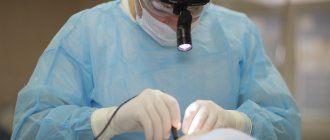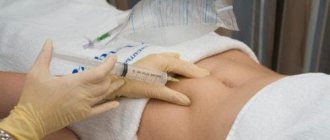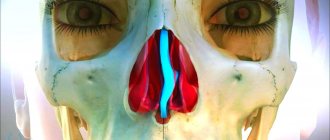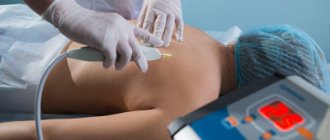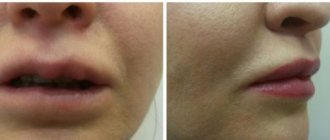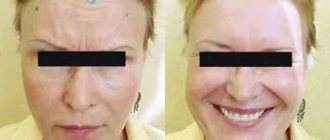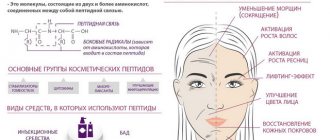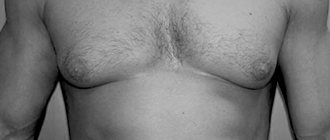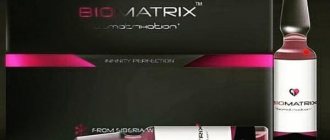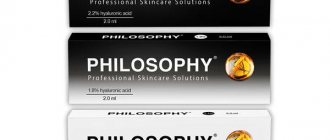Consequences that can result from a deviated nasal septum
Swelling of the nasal turbinates
Due to deformation of the nasal septum, the air flow changes. This irritates the mucous membrane, and subsequently the nasal turbinates swell.
They increase in size, fill the nasal cavity and close the entrance to the sinuses. This contributes to the manifestation of the so-called “greenhouse effect”, which can cause purulent sinusitis, polyps and cysts.
Another consequence of swelling of the nasal turbinates is the feeling that mucus is flowing down the back wall of the throat, and patients also complain of a lump in the throat that does not go away. They want to cough up, spit out this lump, but they can’t. The fact is that the edema does not allow physiological fluid to pass through the larynx, which is released, and it seems to “get stuck”.
Problems with nasal breathing (to complete absence)
The most common symptom of a deviated septum is difficulty breathing or no breathing. Most often, once in this situation, patients quickly realize the need for septoplasty, since it is difficult to live with complicated nasal breathing.
Sinusitis of the paranasal sinuses
Sinusitis is an inflammation of the sinuses. This disease can occur due to the fact that a deviated nasal septum blocks the outflow of inflammatory secretions and mucus from the sinuses, and this will lead to their inflammation (sinutitis). Sinusitis can provoke the development of the following complications:
- pharyngitis (inflammation of the mucous membrane of the back of the throat);
- bronchitis, pneumonia (pneumonia);
- otitis (inflammation of the ears);
- meningitis (inflammation of the lining of the brain or spinal cord).
Snoring and mouth breathing = problems with ENT organs
A deviated nasal septum is one of the most common causes of snoring. Daily snoring and mouth breathing can lead to:
- tracheitis (inflammation of the trachea: upper respiratory tract);
- laryngitis (inflammation of the mucous membranes of the larynx);
- sinusitis.
Oxygen deficiency of the brain
The main signs of oxygen deficiency are:
- drowsiness;
- fatigue;
- fatigue;
- lethargy.
Often doctors, when examining these patients, shrug their shoulders and cannot find the true reason for this feeling. Patients spend a lot of time trying to get a correct diagnosis. But everything is quite banal: due to the curvature of the nasal septum, swelling of the nasal turbinates occurs, which complicates the access of oxygen to the brain.
Types of deviated nasal septum
S-shaped curvature of the nasal septum
C-shaped deviated nasal septum
S-shaped (antero-posterior) curvature of the nasal septum
Deviation of the nasal septum in relation to the bone crest of the upper jaw
Deviation of the nasal septum and bone crest of the upper jaw
Is it necessary to have septoplasty if nothing bothers you?
Be careful: even with a deviated septum, your nasal breathing may not change in a way that you will notice. In this case, you must follow all the instructions of your treating otolaryngologist.
In such cases, loss of nasal breathing function may occur after several years, when compensation from other structures has passed.
The sooner you find out whether you have a deviated septum or not, the better for your health.
Are there any other ways to treat a septum?
No, the curvature can only be corrected through surgery. The only difference is that the surgery can have different volumes, determined by the doctor during diagnosis.
Septoplasty - surgical correction of the nasal septum
Septoplasty usually involves the most gentle surgical removal of the deviated parts of the nasal septum, previously detached from the covering mucosa and perichondrium or periosteum.
Deviated areas of the nasal septum that can be straightened are straightened in place and maintained.
Thus, by preserving our own tissues as much as possible, we ensure the preservation of the structure of the nasal septum, its strength and functionality. Incisions and sutures are made deep in the nasal cavity and are not visible from the outside.
Differences of septoplasty
Partial removal
In case of any local (small) curvature of the septum (in cases where it protrudes towards the side wall of the nose), an operation is performed during which only that part of the septum in which locally changed cartilage or bone is present is removed. At the Pirogov clinic, only partial removal with correction is practiced, and we use endoscopic equipment.
Removing all hard base
One of the complex operations is the complete removal of the hard base of the septum: the specialist will remove both the bone and the curved cartilage. He will fix them and put them back. This method is considered outdated; it is not used in Pirogov’s clinic.
Endoscopic equipment
Previously, septoplasty was performed using a special hammer. It was a rather bloody method. Nowadays, endoscopic equipment is used to ensure minimal trauma, more careful operation and faster rehabilitation. Therefore, you don’t have to worry that they will break something for you. In fact, doctors will very carefully and with the help of specialized instruments lift the nasal mucosa (without damaging it in any way), carry out all the necessary manipulations, and then put the mucous membrane back in its original place.
By the way, in the Pirogov clinic on Vasilievsky Island, endoscopic septoplasty is most often performed (using a special device - an endoscope). It differs from other methods in that it involves the least amount of trauma, which leads to rapid rehabilitation of the patient.
Instructions for Nasonex
Intranasally.
Nasonex® is used in the form of intranasal inhalation of a suspension contained in a spray bottle. Inhalations are carried out using a special dispensing nozzle on the bottle.
Before using Nasonex® nasal spray for the first time, it is necessary to “calibrate” it by pressing the dispensing device 6-7 times. After “calibration”, a stereotypical delivery of the drug is established, in which with each press of the button approximately 100 mg of mometasone furoate suspension is released, containing mometasone furoate monohydrate in an amount equivalent to 50 μg of chemically pure mometasone furoate. If the nasal spray has not been used for 14 days or longer, recalibration is necessary before using it again.
Before each use, shake the spray bottle vigorously.
Treatment of seasonal or year-round allergic rhinitis
For adults (including the elderly) and adolescents over 12 years of age, the usually recommended preventive and therapeutic dose of the drug is 2 inhalations (50 mcg each) into each nostril, once (total daily dose 200 mcg). After achieving the desired therapeutic effect for maintenance therapy, it is advisable to reduce the dose to 1 inhalation in each nostril 1 time per day (total daily dose 100 mcg).
If a reduction in the symptoms of the disease cannot be achieved by using the drug at the recommended therapeutic dose, the daily dose can be increased to 4 inhalations into each nostril once a day (total daily dose 400 mcg). After the symptoms of the disease decrease, a dose reduction is recommended.
The onset of action of the drug is usually noted clinically within the first 12 hours after the first use of the drug.
Children 2–11 years of age: the recommended therapeutic dose is 1 inhalation (50 mcg) into each nostril once a day (total daily dose is 100 mcg).
Auxiliary treatment of exacerbations of sinusitis
Adults (including the elderly) and adolescents over 12 years of age: the recommended therapeutic dose is 2 inhalations (50 mcg) into each nostril 2 times a day (total daily dose 400 mcg).
If a reduction in the symptoms of the disease cannot be achieved by using the drug at the recommended therapeutic dose, the daily dose can be increased to 4 inhalations into each nostril 2 times a day (total daily dose - 800 mcg). After the symptoms of the disease decrease, a dose reduction is recommended.
After 12 months of treatment with Nasonex® nasal spray, there were no signs of atrophy of the nasal mucosa; In addition, mometasone furoate tended to contribute to the normalization of the histological picture when examining biopsy specimens of the nasal mucosa.
Rehabilitation after septoplasty
At the Pirogov Clinic, the patient is discharged after septoplasty the very next day! At the very end of the operation, tampons will be placed in your nose to help fix the new septum in the desired position. After some time (depending on the complexity of the surgical intervention), they will be removed for you (it won’t hurt as much as before), and then you will remember what it means to “breathe deeply.”
It is worth noting that tampons have also changed: if previously they were long and homemade (from bandages), now small tampons are used that absorb blood, but at the same time heal the mucous membrane. Also, modern tampons enlarge and occupy the nasal cavity, thereby squeezing the vessels to prevent bleeding.
You should not put any strain on your body for 1-2 weeks, although you will not need bed rest. For a quick recovery, it is important to correctly follow all the instructions of your treating specialist.
Nasal drops after implantation
After implantation in the lateral parts of the upper jaw, especially if a sinus lift operation was performed during implantation, nasal drops are almost always prescribed.
Patients are interested in why these drops are prescribed and how long they need to drip.
Let's first discuss what a sinus lift is. Often in the lateral parts of the upper jaw after removal there is very little bone left and there is practically nothing to place the implant into. It is necessary to do bone grafting in order to build enough bone in this section for implantation.
In this case, the implant surgeon makes a small hole in the bone, carefully lifts the mucous membrane of the maxillary sinus (sinus) and places bone material in the resulting space. Over time, bone will form in this area that is good enough to support the implant.
But any operation on the maxillary sinus can cause local inflammation and, as a result, nasal congestion. If the nasal passages are clogged and a person tries to clear them by blowing his nose and forcefully forcing air through the nose, then excess pressure forms inside the maxillary sinus.
This can cause damage to the mucous membrane, and sometimes the formation of an anastomosis between the maxillary sinus and the oral cavity, because in the bone there is a small window through which bone material was laid, and it is covered on top with only a thin layer of mucous membrane.
Therefore, patients are given strict instructions to use vasoconstrictor drugs and under no circumstances create excess pressure in the nose in the first days until the wound heals.
You can’t blow your nose (especially, as many people like, with great force and volume), you can’t blow up balloons, you can’t kiss, creating negative pressure in your mouth, you can’t try to suck something through a straw, etc. Physical activity, swimming and diving, airplane flights and anything that can lead to severe pressure changes in the nose and mouth are excluded.
In this case, it is necessary to drip vasoconstrictor drops into the nose to relieve local swelling after surgery and so that the nose can breathe freely and is not stuffy.
Usually it is enough to use these drops for five days. It is no longer recommended, no matter how much one would like it, because... with prolonged use of vasoconstrictors, one becomes so accustomed to them that the nose then refuses to work without them. Without the usual drops, the mucous membrane swells and the nose does not breathe at all. This phenomenon is called vasomotor rhinitis. A person practically becomes addicted to vasoconstrictors, like a drug, and then cannot live without them; his nose immediately becomes blocked.
Usually, surgeons write 5 days in their recommendations to prevent complications after sinus lifting, but this is already the limit, no more is needed.
This rule applies not only to sinus lifting. In any case, even with a simple runny nose, acute respiratory viral infection or flu, using vasoconstrictor drops for more than five days is not recommended due to the risk of the onset of the same vasomotor rhinitis.
It’s better not to let this happen, because... It will then take a long time to remove the body from such a state and without a specialist it will be difficult.
Modern septoplasty
Currently, gentle methods for correcting the nasal septum have been developed, such as cristotomy, endoscopy, thermoplasty, etc. using a laser, radio frequency system, etc. These methods are used only for minor deformities and can be performed on an outpatient basis.
In modern clinics, the choice of surgical method is determined individually, taking into account the anatomical features and condition of the patient.
The duration of septoplasty, as a rule, is no more than 1 hour, although there are complex deformities that require more time for correction.
The operation ends with the installation of nasal tampons to stop bleeding, as well as to fix the nasal septum in the desired position.
